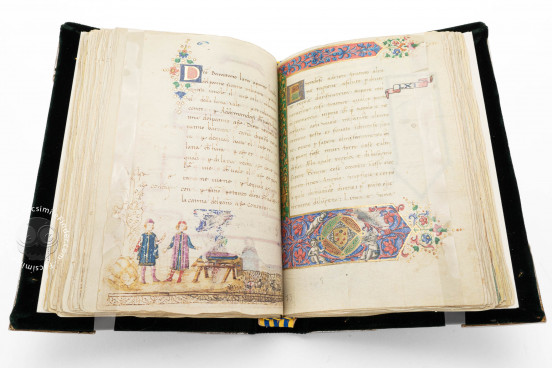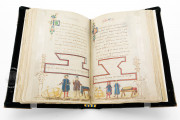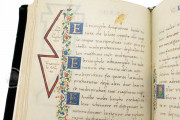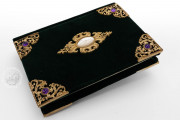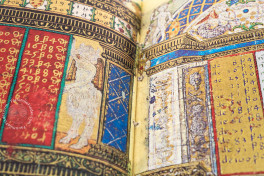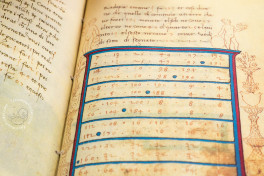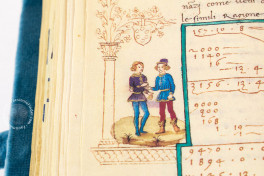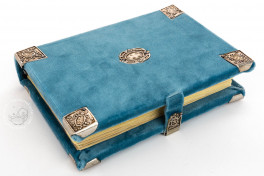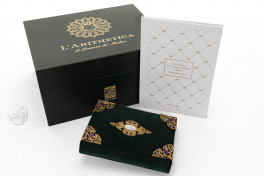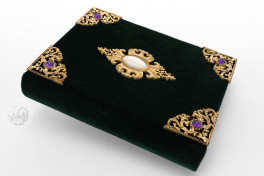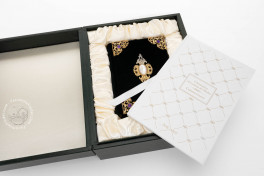The manuscript of the Treatise on Arithmetic and Geometry by Filippo Calandri in the Biblioteca Riccardiana is a luxury object that offers a glimpse of the practical side of doing business in fifteenth-century Florence. The manuscript was copied and illuminated in the last quarter of the fifteenth century. The illumination includes a full-page portrait of Pythagoras; eighteen pages of elaborated painted multiplication tables; an incipit page with a fully painted border; and eighty unframed vignettes of varying size and complexity, some filling as much as three-quarters of a page.
The manuscript's creation was patronized by Lorenzo de' Medici, "the Magnificent," and the book was surely intended for the edification and enjoyment of one of his sons, Giovanni or Giuliano. Calandri's dedication of the 1491 print edition of the text to the young Giuliano (b. 1479) makes him perhaps the more likely intended recipient.
Two Illuminators, Two Purposes, Two Palettes
The illumination is thought to have been executed in two campaigns, perhaps separated by years, the first of which was primarily intended to illustrate the mathematical problems in the text. The second campaign focused on elevating the status of the object as an emblem of Medici wealth and taste.
The first illuminator worked on the presentation of the treatise proper (not the opening twelve leaves of multiplication tables) and was responsible for the painted letters and paraph marks and some of the painted vignettes that illustrate the problems. He painted in a conservative Florentine style using a palette of light colors. The second illuminator, who worked with assistants, used more intense hues in starker contrast. He was responsible for the painted pages of multiplication tables, the incipit page to the treatise proper, and some of the vignettes in the treatise, including all the visual references to the Medici family.
Illustrating the Business of Business
The painted vignettes illustrate the practical problems set forth in the text. These range from how many sails to raise on a sailing voyage (fols. 91v and 95v) to how to barter (e.g., fol. LVIv). A series of scenes addresses the question of how to share profits in a business partnership (fols. XXXXIII-LX).
Reminders of Medici Patronage
Versions of the Medici coat of arms are featured on many pages of the opening section (fols. 2-10), and the family symbols of lute and diamond-studded rings are incorporated into the border of the treatise's incipit page (fol. Ir). Medici mottos (in French and Latin) are also to be found.
A Spaniard Working in Florence?
Scholarly speculation concerning the identity of the illuminators has ranged widely and has raised the name of Pedro Berruguete, a Spanish painter probably active in Urbino in the 1470s. His name, however, has otherwise been almost exclusively associated with panel painting, and he seems to have been active in Spain during most of the time the manuscript was illuminated.
Solutions Highlighted
The Italian-language text is written in a clear Humanistic Cursive. The Arabic numerals of multiplication tables (fols. 2r-10v) are written in gold on colored grounds of blue, green, red, and yellow, with elaborate fictive classicizing architectural surrounds. The fractions on fols. I-X are written on colored grounds surrounded by flaming bands of contrasting colors, and the solutions to the mathematical problems are framed by painted bands of red, blue, and green.
A Conservation Binding
The manuscript is now bound in blue velvet with metal furnishings, which replaced a nineteenth-century binding.
We have 2 facsimiles of the manuscript "Treatise on Arithmetic and Geometry by Filippo Calandri":
- Tratado de Aritmética de Lorenzo el Magnífico facsimile edition published by Patrimonio Ediciones, 2002
- L'Aritmetica di Lorenzo de' Medici facsimile edition published by ArtCodex, 2001


